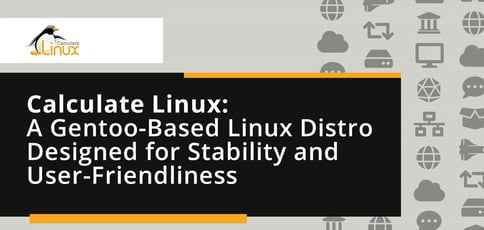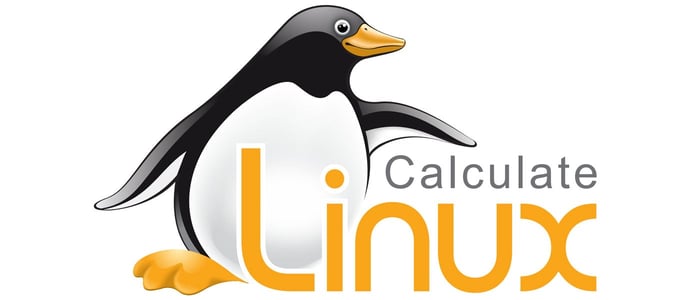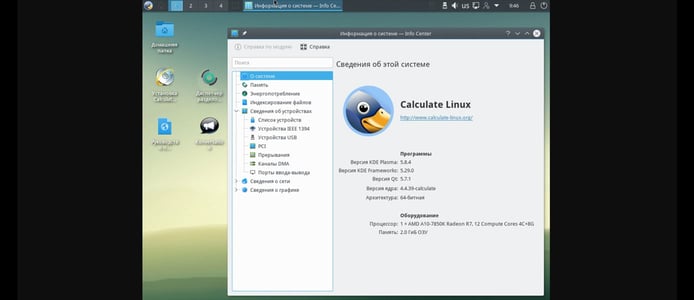
TL; DR: Calculate Linux, a Linux distribution based on Gentoo, is an open-source solution initially created for use at the Russian packaging company Calculate Ltd. Today, users are drawn to the solution’s adaptability, rolling-release approach to updates, and developer-friendly nature. With regular updates based on social media polls, Calculate Linux is poised to serve as a Gentoo alternative for decades to come.
As any open-source aficionado knows, developers bring Linux kernels to life using what’s known as a distribution — an operating system that distributes the kernel along with a collection of supporting software and utilities.
There are nearly 1,000 Linux distributions to choose from, the most popular of which include MX Linux, Manjaro, Linux Mint, Ubuntu, and Debian. Each flavor has its use case and perks: Linux Mint, for example, provides a familiar desktop experience on personal computers, while lightweight distros like PeppermintOS are explicitly designed for older machines.
Others stand out for their flexibility. Gentoo, a Linux distribution built using the package management system Portage, is exceptionally configurable and can be adapted to suit nearly any application.

Calculate Linux is a developer-friendly distribution based on the highly adaptable Gentoo.
The distribution also offers detailed user controls and high performance. The downside is its steep learning curve. Without high-level knowledge, it’s difficult for many users to get the most out of Gentoo. But the beauty of open-source is that developers can create their own solutions to overcome such limitations.
Take Calculate Linux, a Gentoo-based Linux distribution, for example. The ready-to-use solution was built to empower users to leverage Gentoo’s adaptability while eliminating complexity. With system assembly, configurations, and updates managed by Calculate Utilities, the distribution eliminates significant barriers in terms of time and effort.
“Many Calculate users appreciate that they only have to install the system once and then just update it regularly — some have experienced about 10 years of nonstop usage,” said Alexander Tratsevskiy, Founder and Developer at Calculate Linux. “Others like that the Portage tree is not tampered with in any way on Calculate Linux, making it 100% compatible with pure Gentoo.”
Calculate Ltd.’s Take on Gentoo Linux
Calculate Linux’s roots go back 15 years when the Russian cardboard packaging company Calculate Ltd. first built the Linux distribution for internal use.
“In 2006, Calculate Ltd. decided to convert its employees’ workstations from Windows to Linux,” Alexander said. “Back then, our servers were running on RedHat and SUSE Linux.”
The company was looking for a reasonably stable distribution that it could install on both desktops and servers and make available through a simple log-in process. It also sought a solution with automatic desktop and application configuration that allowed developers to store user account information directly on the server, making it accessible from any computer.

Calculate Linux was first built for use at Russia’s Calculate Ltd.
“At the time, our server with SUSE Linux inside needed to be reinstalled,” Alexander said. “It had no KVM access. We decided to try to remotely install Gentoo on it. Everything worked out well. We were so impressed by the quality and flexibility of Gentoo that it encouraged us to build our own Gentoo Stage4 image for desktops.”
Calculate Ltd.’s employees moved to the new system, and in 2007, the company decided to make the software publically available through an open-source license.
“We created a website to share our work with the Russian Gentoo community,” Alexander said. “Only a year and a half later, we started distributing it as a bootable ISO image, making Calculate Linux an open-source solution for rapid deployment in corporate environments.”
Numerous Optimizations Under a Rolling Release Cycle
Calculate Linux is updated under a rolling-release distribution, meaning that users can install the system once and simply update it, rather than reinstalling new software versions over previous ones. “The rolling-release approach keeps your Calculate Linux system up to date while providing stable versions of the libraries and the latest versions of desktop applications,” Alexander explained.
It is available in numerous editions: KDE (CLD), Cinnamon (CLDC), LXQt (CLDL), Mate (CLDM) and Xfce (CLDX or CLDXS); Calculate Directory Server (CDS), Calculate LinuxScratch (CLS), and Calculate Scratch Server (CSS).
Over the years, Alexander said his developers have worked to ensure simplicity and ease-of-use with each release.
“For example, it became obvious that we should spare the user the burden of choosing software during installation and watching endlessly as packages are installed,” he said. “It is so much better to have several distributions with different desktops that can be installed in a few minutes.
Calculate Linux gained popularity over time, attracting former Windows and Ubuntu users. At that point, to help spur further growth, the team added a GUI installer and update tools.

The ready-to-use solution was built to enable adaptability while eliminating complexity.
Alexander and his team also frequently surveyed the community to inform ongoing development. In one instance, they distributed a survey to gauge preferences regarding daemon processes.
“The survey showed that the Calculate Linux community preferred the OpenRC init system to systemd, even though systemd booted faster,” he said. “We made all sorts of optimizations, ranging from the runtime utilities, services startup order, and the ISO compression algorithm to initramfs and kernel modules. When I tested several distributions on a VPS recently, I felt proud that Calculate Scratch Server was much faster to boot.”
Calculate Linux’s version numbering follows the year and month of release. The latest update, Version 20.6, was released on June 21, 2020. Today, the Linux distribution boasts a good list of features, including tools for multi-boot LiveUSB creation and ISO customization.
Alexander said his favorite feature is the ability to work with utilities templates, which define system settings.
“This concept of ours has not changed much over 15 years,” he said. “The templates enhance the Gentoo experience by adding new features, such as the configuration of the installed applications from within a user profile.”
Rewriting Calculate Linux Utilities in Python 3
When it comes to internal development, the Calculate Linux team works to ensure that any innovations it introduces are relevant and widely applicable to user needs based on regular social media polls.
“As we have a large Russian-speaking community, the best platform at the moment seems to be the Vkontakte networks, where we get 100 to 150 responses to each survey,” he said. “This gives us a better idea of what the users’ needs are to keep us going in the right direction.”
After narrowing down which features to implement, the team assesses their complexity, runs initial tests, and sets up an implementation schedule. In addition to helping corporate users in general, these developments provide Calculate Ltd. with a competitive advantage.
“I would mention, for instance, the integration of Android smartphones with our cloud structures,” Alexander said. “The phones are configured and updated with Calculate Utilities. At Calculate Ltd., 60 employees are already using corporate phones configured in such a way. It takes literally about two minutes to set up a ready-to-go device, including the software installation.”
The team is currently focused on rewriting Calculate Utilities in Python 3.
“Rather than porting the code, we have chosen to rethink its logic completely,” Alexander said. “This is quite a job, and we have been working on it for more than a year. The utilities are being rewritten with years of experience in mind and should be free of the shortcomings the current version has.”
HostingAdvice.com is a free online resource that offers valuable content and comparison services to users. To keep this resource 100% free, we receive compensation from many of the offers listed on the site. Along with key review factors, this compensation may impact how and where products appear across the site (including, for example, the order in which they appear). HostingAdvice.com does not include the entire universe of available offers. Editorial opinions expressed on the site are strictly our own and are not provided, endorsed, or approved by advertisers.
Our site is committed to publishing independent, accurate content guided by strict editorial guidelines. Before articles and reviews are published on our site, they undergo a thorough review process performed by a team of independent editors and subject-matter experts to ensure the content’s accuracy, timeliness, and impartiality. Our editorial team is separate and independent of our site’s advertisers, and the opinions they express on our site are their own. To read more about our team members and their editorial backgrounds, please visit our site’s About page.

